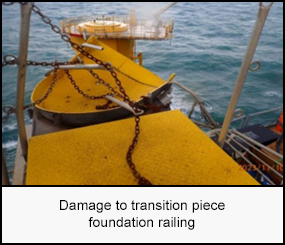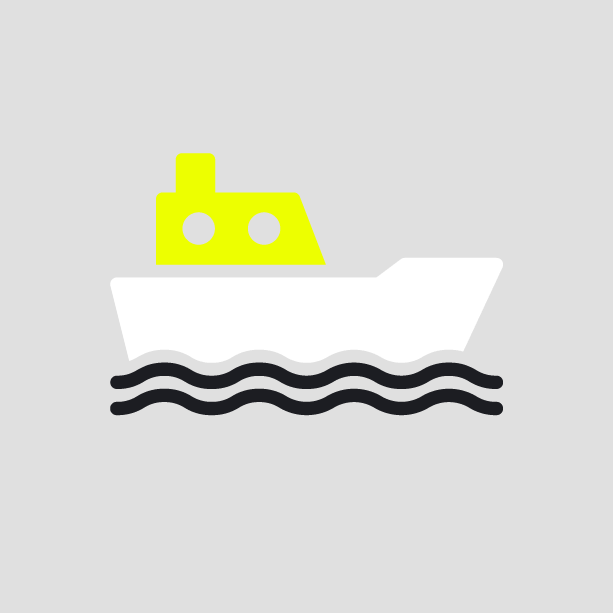-
What happened?
During stormy weather, a gangway used for foundation access detached from a turbine installation vessel in standby position.
The gangway tilted, sheared off at the platform connection point, and fell into the sea.
No personnel were present near the gangway or foundation at the time and no injuries occurred.
The falling gangway caused damage to the Transition piece (TP) foundation railing.
A Remote operated vehicle (ROV) survey was initiated to check for obstruction risks to the vessel’s spud cans and potential damage to subsea infrastructure.
A gangway recovery operation was later launched.

-
Why did it happen?
Wind gusts exceeded the product’s maximum threshold (24m (79ft)/sec threshold vs. 29m (95ft)/sec actual).
The gangway was not removed or secured despite procedures requiring action at above 20m (66ft)/sec wind speed.
Lashing to the TP was not implemented, though it was specified in the gangway manufacturer’s guidelines.
Lack of pre-emptive action or risk anticipation during worsening weather conditions.

-
What did they learn?
Gangways must be removed or properly secured when forecasted wind exceeds threshold limits.
Manufacturer specifications and operational procedures must be strictly followed.
There needs to be stronger weather monitoring and proactive decision-making are needed during standby periods.
Risk of structural and subsea damage requires timely inspection using ROV after such events.
Emphasis on preventive checks before storms to avoid secondary damages and operational delays.

-
Ask yourself or your crew
Are we consistently monitoring weather forecasts and acting ahead of threshold conditions?
Do we always follow manufacturer specifications for equipment in all weather scenarios?
How do we ensure that procedures like lashing or gangway removal are verified in time?
How are we prepared for emergency inspections and recovery operations if equipment is lost?
How can we improve communication between crews during standby to avoid incidents like this in the future?

Add to homescreen
Content name
Select existing category:
Content name
New collection
Edit collection
What happened?
During stormy weather, a gangway used for foundation access detached from a turbine installation vessel in standby position.
The gangway tilted, sheared off at the platform connection point, and fell into the sea.
No personnel were present near the gangway or foundation at the time and no injuries occurred.
The falling gangway caused damage to the Transition piece (TP) foundation railing.
A Remote operated vehicle (ROV) survey was initiated to check for obstruction risks to the vessel’s spud cans and potential damage to subsea infrastructure.
A gangway recovery operation was later launched.

Why did it happen?
Wind gusts exceeded the product’s maximum threshold (24m (79ft)/sec threshold vs. 29m (95ft)/sec actual).
The gangway was not removed or secured despite procedures requiring action at above 20m (66ft)/sec wind speed.
Lashing to the TP was not implemented, though it was specified in the gangway manufacturer’s guidelines.
Lack of pre-emptive action or risk anticipation during worsening weather conditions.
What did they learn?
Gangways must be removed or properly secured when forecasted wind exceeds threshold limits.
Manufacturer specifications and operational procedures must be strictly followed.
There needs to be stronger weather monitoring and proactive decision-making are needed during standby periods.
Risk of structural and subsea damage requires timely inspection using ROV after such events.
Emphasis on preventive checks before storms to avoid secondary damages and operational delays.
Ask yourself or your crew
Are we consistently monitoring weather forecasts and acting ahead of threshold conditions?
Do we always follow manufacturer specifications for equipment in all weather scenarios?
How do we ensure that procedures like lashing or gangway removal are verified in time?
How are we prepared for emergency inspections and recovery operations if equipment is lost?
How can we improve communication between crews during standby to avoid incidents like this in the future?
During stormy weather, a gangway detached from a turbine installation vessel and fell into the sea. No injuries occurred. The TP railing was damaged, prompting an ROV survey and a recovery operation.













